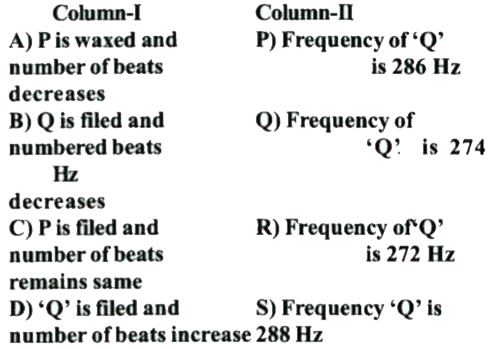A tuning fork of unknown frequency when sounded with another tuning fork of frequency 256 Hz produces 4 beats per second, and on loading with a little amount of wax, it again produces 4 beats per second. The unknown frequency is____________.
To solve the problem, we need to determine the unknown frequency of the tuning fork based on the information provided about the beats produced when it is sounded with a known frequency of 256 Hz.
1. Understanding Beats:
The phenomenon of beats occurs when two sound waves of slightly different frequencies interfere with each other. The beat frequency is given by the absolute difference between the two frequencies.
Beat Frequency=|fu−fk|
where fu is the unknown frequency and fk is the known frequency (256 Hz).
2. Given Information:
The problem states that when the unknown tuning fork is sounded with the 256 Hz fork, it produces 4 beats per second. Therefore, we can write:
|fu−256|=4
3. Setting Up Equations:
This absolute value equation gives us two possible scenarios:
- fu−256=4
- fu−256=−4
Solving these equations, we get:
- From fu−256=4:
fu=256+4=260 Hz
- From fu−256=−4:
fu=256−4=252 Hz
Thus, the unknown frequency fu could be either 260 Hz or 252 Hz.
4. Loading with Wax:
The problem states that after loading the tuning fork with wax, it again produces 4 beats per second. Loading the fork with wax generally decreases its frequency.
5. Analyzing the Effect of Loading:
- If the original unknown frequency was 260 Hz, after loading, it could decrease to a frequency that is still close to 256 Hz, allowing for a beat frequency of 4 Hz (e.g., it could decrease to 256 Hz or 252 Hz).
- If the original unknown frequency was 252 Hz, loading it would further decrease its frequency, which would increase the beat frequency instead of keeping it at 4 Hz.
6. Conclusion:
Since after loading the frequency still produces 4 beats per second, the only feasible original frequency for the unknown tuning fork is:
fu=260 Hz
Final Answer:
The unknown frequency is 260 Hz.
---
The phenomenon of beats occurs when two sound waves of slightly different frequencies interfere with each other. The beat frequency is given by the absolute difference between the two frequencies.
where fu is the unknown frequency and fk is the known frequency (256 Hz).
The problem states that when the unknown tuning fork is sounded with the 256 Hz fork, it produces 4 beats per second. Therefore, we can write:
|fu−256|=4
This absolute value equation gives us two possible scenarios:
- fu−256=4
- fu−256=−4
- From fu−256=4:
fu=256+4=260 Hz
- From fu−256=−4:
fu=256−4=252 Hz
The problem states that after loading the tuning fork with wax, it again produces 4 beats per second. Loading the fork with wax generally decreases its frequency.
- If the original unknown frequency was 260 Hz, after loading, it could decrease to a frequency that is still close to 256 Hz, allowing for a beat frequency of 4 Hz (e.g., it could decrease to 256 Hz or 252 Hz).
- If the original unknown frequency was 252 Hz, loading it would further decrease its frequency, which would increase the beat frequency instead of keeping it at 4 Hz.
Since after loading the frequency still produces 4 beats per second, the only feasible original frequency for the unknown tuning fork is:
fu=260 Hz
The unknown frequency is 260 Hz.
Similar Questions
A fork of unknown frequency when sounded with one of frequency 288 Hz gives 4 beats per second and when loaded with a piece of wax again gives 4 beats per second. How do you account for this and what was the unknow frequency ?
View SolutionA tuning fork of unknown frequency gives 4beats with a tuning fork of frequency 310 Hz. It gives the same number of beats on filing. Find the unknown frequency.
View Solution
Knowledge Check
- Question 1 - Select One
When a tuning fork A of unknown frequency is sounded with another tuning fork B of frequency 256Hz, then 3 beats per second are observed. After that A is loaded with wax and sounded, the again 3 beats per second are observed. The frequency of the tuning fork A is
A250HzB253HzC259HzD262Hz - Question 2 - Select One
Tuning fork A when sounded with a tuning for B of frequency 480 Hz gives 5 beats per second. When the prongs of A are loaded with wax, it gives 3 beats per second. The original frequency of A is
A475HzB485 HzC483 HzD477 Hz - Question 3 - Select One
A tuning fork 'P' of frequency 280Hz produces 6 beats/s with unknown tuning fork 'Q'
 AABCDQRSRBABCDQRQPCABCDP.QQ.RR.SPDABCDR.SQ.RSR
AABCDQRSRBABCDQRQPCABCDP.QQ.RR.SPDABCDR.SQ.RSR
A tuning fork of unknown frequency produces 4 beats per second when sounded with another tuning fork of frequency 254 Hz. It gives the same number of beats per second when unknown tuning fork loaded with wax . The unknown frequency before loading with wax is
View SolutionA tuning fork of frequency 100 when sounded together with another tuning fork of unknown frequency produces 2 beats per second. On loading the tuning fork whose frequency is not known and sounded together with a tuning fork of frequency 100 produces one beat, then the frequency of the other tuning fork is
View SolutionIf a tuning fork of frequency 512Hz is sounded with a vibrating string of frequency 505.5Hz the beats produced per sec will be
View SolutionA tuning fork of frequency 100 when sounded together with another tuning fork of unknown frequency produces 2 beats per second. On loading the tuning fork whose frequency is not known and sounded together with a tuning fork of frequency 100 produces one beat, then the frequency of the other tuning fork is
View SolutionA tuning fork when sounded with tuning fork of frequency 256 produces 4beats/sec and when sounded with another of frequency 250 produces 2beats/sec . The frequency of the fork is -
View Solution

